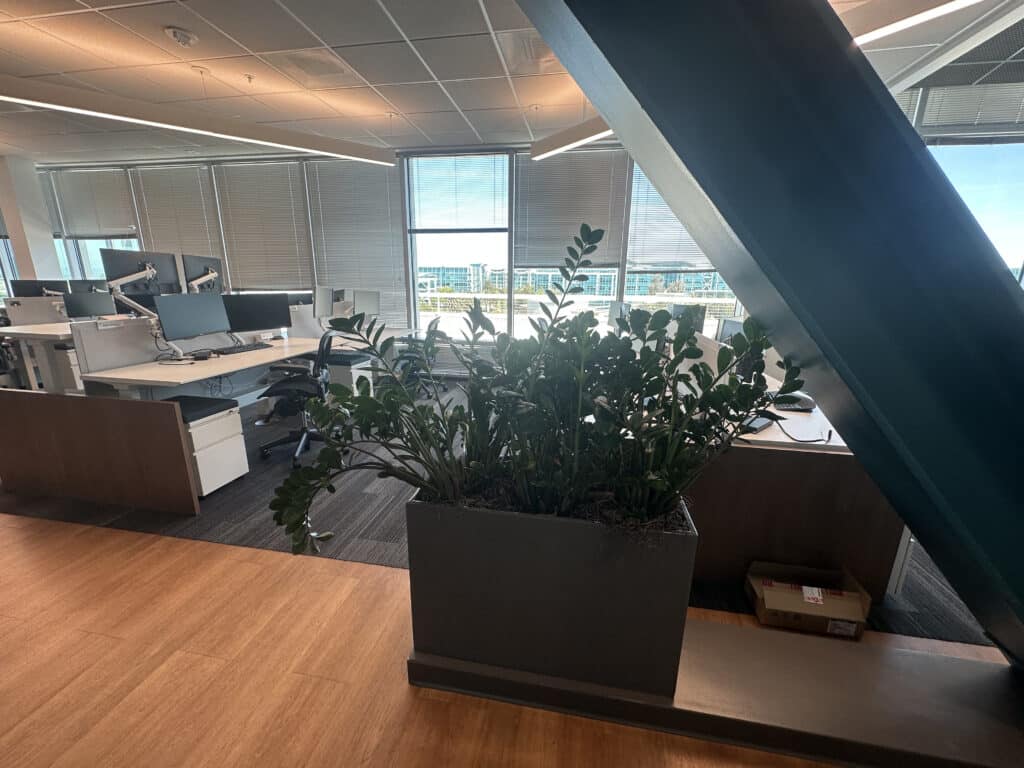Indoor plants do far more than brighten up a workspace, they actively support well-being, improve air quality, and contribute to a more inviting office culture. But without proper lighting, even the hardiest plant can struggle to thrive. Understanding how light interacts with indoor plants is essential for maintaining long-term plant health in any environment, especially in commercial and office settings.
Light is the single most important factor in a plant’s life cycle. It influences everything from leaf color to growth speed and overall vitality. For indoor setups where natural light is inconsistent or limited, strategic planning is key to making sure plants not only survive but flourish.
Why Lighting Matters for Indoor Plants
Photosynthesis, the process by which plants convert light into energy, is directly tied to how much light they receive. Without enough of it, growth slows, leaves may drop, and the plant becomes susceptible to disease and pests. In office spaces where artificial lighting often dominates, selecting the right lighting setup and plant type becomes a matter of both science and design.
Different species have varying light requirements, making it crucial to match the right plant to the right lighting condition. Overexposure can lead to scorched leaves, while underexposure may result in leggy, discolored growth.
A well-lit environment ensures your plants can maintain their function and appearance year-round, especially when supported by smart seasonal rotation. This seasonal plant guide outlines ideal plant choices for each season, helping ensure plants receive the right light when it matters most.
Common Signs of Poor Lighting
One of the most overlooked problems in plant care is misreading the subtle signs that lighting isn’t sufficient, or is too harsh. Here are key indicators that your indoor plants may be struggling due to lighting issues:
- Yellowing or browning leaves: This may indicate overexposure or scorching from intense light.
- Sparse or leggy growth: A plant that is stretching toward the nearest window or bulb is likely craving more light.
- Leaf drop or lack of new growth: These symptoms often point to chronic under-lighting.
- Color fading: Variegated leaves that lose their distinct markings may not be getting enough direct or filtered light.
Monitoring your plants regularly helps catch these early warning signs and allows adjustments before lasting damage occurs.
Matching Light Types to Plant Needs
Not all lighting is created equal. Office and indoor environments often rely on artificial lighting, which can differ widely in intensity and spectrum. Knowing what’s available and what your plants need is critical for success.
Natural light (full-spectrum sunlight):
- Best for light-loving species such as succulents and cacti
- South-facing windows typically offer the most consistent exposure
Fluorescent lighting:
- Ideal for low- to medium-light plants like pothos, ZZ plants, or peace lilies
- Produces low heat, making it safe for close proximity
LED grow lights:
- Adjustable spectrum and energy-efficient
- Great for supplementing areas without windows or where natural light is minimal
Before placing any greenery, assess the type of light available and pair it with plants known to tolerate or thrive in those specific conditions. For those focused on easy-care solutions, explore this guide to low-maintenance plants suited to various lighting levels.
Light Management Tips for Indoor Plant Success
A successful lighting plan balances both aesthetics and biology. Here’s how to ensure your setup gives plants everything they need:
- Rotate plants regularly
Even lighting can be inconsistent throughout the day. Turning plants helps them grow evenly and prevents leaning. - Use sheer curtains or blinds
Diffused sunlight protects shade-loving plants from burning and allows even distribution across the workspace. - Monitor the seasons
Light angles change as the year progresses. A bright corner in summer may become shaded in winter. - Group by light tolerance
Create micro-environments by clustering plants with similar lighting needs near each other for easier maintenance. - Clean the leaves
Dust buildup can reduce a plant’s ability to absorb light. Gently wipe leaves with a damp cloth to keep them photosynthetically efficient.
Lighting tools like timers and light meters can also support long-term plant health by ensuring consistency across varying office conditions.
When Expert Help Becomes Essential
While it may be tempting to handle plant installation and care in-house, the complexity of lighting dynamics and plant biology often makes professional support the wiser option. Indoor environments present challenges that go beyond aesthetics, including changing light availability, inconsistent HVAC exposure, and space constraints.
Professional plant care teams can assess your lighting levels, recommend the right species, and monitor your plant layout to ensure continued health. They also handle seasonal updates and necessary replacements, taking the guesswork out of lighting management entirely.
Let the Light Work for You
Light is not just an environmental factor, it’s a vital resource that directly shapes the success of your indoor plants. Whether your workspace is bathed in sunshine or relies entirely on overhead bulbs, the right strategy can make all the difference. Ready to design a light-friendly indoor garden? Reach out to The Wright Gardner to illuminate your office with expert solutions that bring your space and your plants to life.

